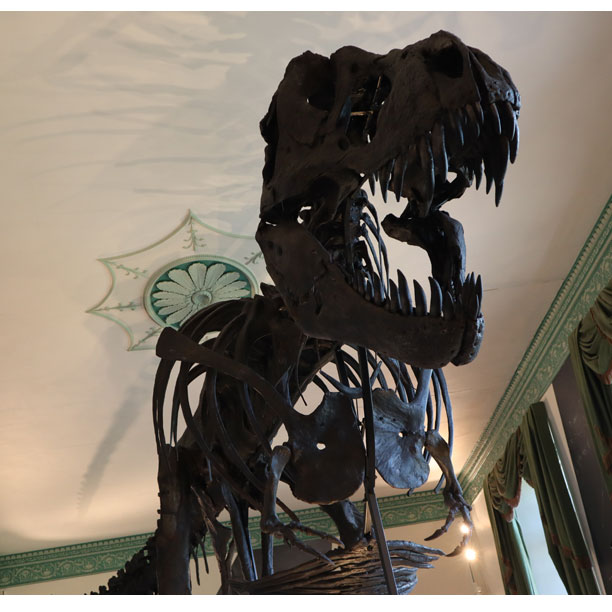New Research Supports Asian Origin for Tyrannosaurus rex
The direct ancestor of the iconic Tyrannosaurus rex came from Asia. Newly published research lends weight to the theory that the direct ancestor of Tyrannosaurus rex dispersed into North America from Asia via an ancient land bridge. Fossils of T. rex are known from Canada and the USA. However, there is some evidence to suggest that this super-predator may also have roamed what is now Mexico. The origins of this famous dinosaur, more specifically the Tyrannosaurini, have been hotly debated.
Did the ancestors of T. rex come from Asia or did its ancestors evolve in North America (southern Laramidia)?

The spectacular Titus the T. rex exhibit at Wollaton Hall. A newly published study (May 2025) supports the theory that the ancestors of the iconic Tyrannosaurus rex originated in Asia. Picture credit: Everything Dinosaur.
Picture credit: Everything Dinosaur
The Origins of the Iconic Tyrannosaurus rex
Previous studies had suggested that the ancestors of the iconic Tyrannosaurus rex migrated into North America from Asia. This theory was primarily based on the closer taxonomic relationship that T. rex has with Asian tyrannosaurids such as Zhuchengtyrannus and Tarbosaurus. Tyrannosaurus rex was more distantly related to Laramidian tyrannosaurids such as Daspletosaurus and Teratophoneus. So, based on this evidence, it was thought that the lineage of tyrannosaurs that were direct ancestors of the “Tyrant Lizard King” probably evolved in Asia.
Dalman et al in their scientific description of Tyrannosaurus mcraeensis (2024) proposed that the Tyrannosaurus genus evolved in southern Laramidia. Their theory was underpinned by the Late Campanian–Early Maastrichtian age of the T. mcraeensis holotype. However, doubt has been cast over the exact age of the holotype fossil material.
In this new study, a biogeographical analysis of the Tyrannosauridae family, particularly the tribe Tyrannosaurini suggests that tyrannosaurines diversified in the Late Campanian. This diversification supports the idea of a migration of ancestors of T. rex from Asia into North America.
To read Everything Dinosaur’s blog post about Tyrannosaurus mcraeensis: A New Tyrannosaurus Species is Described.
Tyrannosaurus Genus Likely Endemic to North America
The research team conclude that Tyrannosaurus is likely an endemic, North American genus. The ancestor of the genus dispersed into North American biotas, where it would give rise to Tyrannosaurus. In addition, gigantism occurred numerous times within the Tyrannosauroidea. It was potentially driven by cooler or cooling climates. This study supports the idea that evolutionary changes within the Dinosauria of the Late Cretaceous was partly in response to climate change. The research illustrates the importance of using climate and ecological data to better understand dinosaurian evolution within wider global climatic shifts.
Shedding Light on the Enigmatic Megaraptoridae
The study also sheds light on the evolution of the enigmatic megaraptors. The Megaraptoridae are a different family of theropod dinosaurs. How closely related they were to the tyrannosaurs remains disputed.
Some megaraptors were giants. They occupied the apex predator niche within many ecosystems. For example, Maip macrothorax from the Late Cretaceous of Argentina may have measured in excess of ten metres long. Whilst the Tyrannosaurini evolved massive skulls and powerful jaws to take down prey. Megaraptorids such as Maip evolved in a different direction. These predators had powerful forelimbs and grasping digits tipped with huge claws.
The picture (above) shows a 1:40 scale model of Maip macrothorax. It is part of the CollectA Deluxe range of prehistoric animal figures.
To view the CollectA Deluxe range of models: CollectA Deluxe Prehistoric Animal Models.
Although the extremely fragmentary nature of the megaraptorid was a limiting factor in this research, the team postulate that the megaraptors most likely diverged from the tyrannosaurs around 170 million years ago in Asia. The megaraptors spread south into what is now Australia, South America and Antarctica via Europe and Africa.
Megaraptorids evolved into the top predators in areas such as Patagonia and Australia, but elsewhere in the world, such as Asia they were replaced by tyrannosaurs.
The scientists would like to extend their modelling but to do so more early tyrannosaur and megaraptor fossils would be needed to make any analysis robust.
The scientific paper: “Rise of the king: Gondwanan origins and evolution of megaraptoran dinosaurs” by Cassius Morrison, Charlie Roger Scherer, Ezekiel V. O’Callaghan, Collin Layton, Colin Boisvert, Mauro Aranciaga Rolando, Leroy Durrant, Pedro Salas, Steven J. R. Allain and Samuel J. L. Gascoigne published by Royal Society Open Science.
For dinosaur toys and figures visit the Everything Dinosaur website: Everything Dinosaur.


